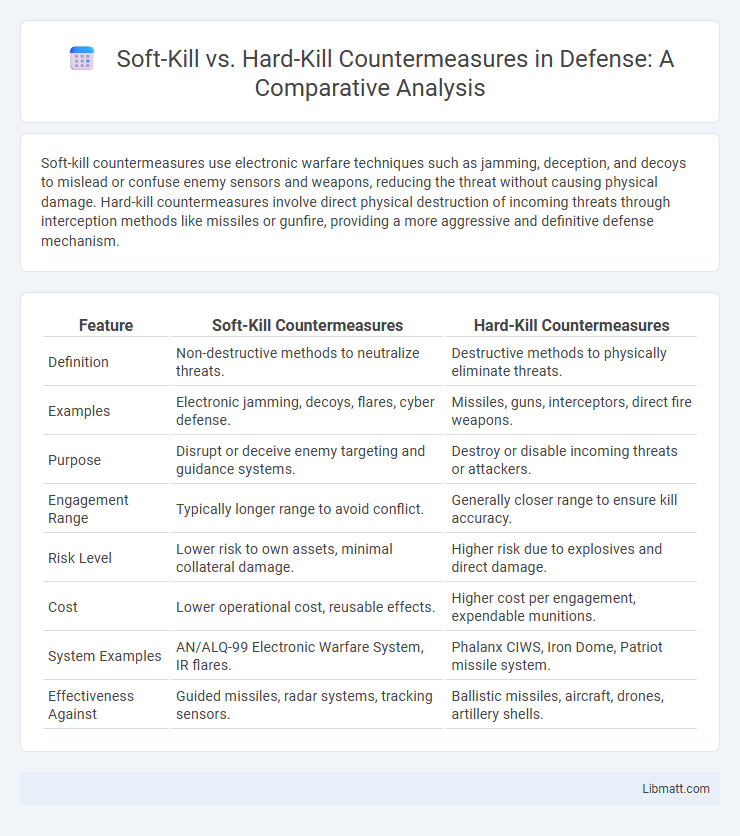Soft-kill countermeasures use electronic warfare techniques such as jamming, deception, and decoys to mislead or confuse enemy sensors and weapons, reducing the threat without causing physical damage. Hard-kill countermeasures involve direct physical destruction of incoming threats through interception methods like missiles or gunfire, providing a more aggressive and definitive defense mechanism.
Table of Comparison
| Feature | Soft-Kill Countermeasures | Hard-Kill Countermeasures |
|---|---|---|
| Definition | Non-destructive methods to neutralize threats. | Destructive methods to physically eliminate threats. |
| Examples | Electronic jamming, decoys, flares, cyber defense. | Missiles, guns, interceptors, direct fire weapons. |
| Purpose | Disrupt or deceive enemy targeting and guidance systems. | Destroy or disable incoming threats or attackers. |
| Engagement Range | Typically longer range to avoid conflict. | Generally closer range to ensure kill accuracy. |
| Risk Level | Lower risk to own assets, minimal collateral damage. | Higher risk due to explosives and direct damage. |
| Cost | Lower operational cost, reusable effects. | Higher cost per engagement, expendable munitions. |
| System Examples | AN/ALQ-99 Electronic Warfare System, IR flares. | Phalanx CIWS, Iron Dome, Patriot missile system. |
| Effectiveness Against | Guided missiles, radar systems, tracking sensors. | Ballistic missiles, aircraft, drones, artillery shells. |
Introduction to Countermeasures: Soft-Kill vs Hard-Kill
Soft-kill countermeasures employ electronic warfare techniques, decoys, and jamming to disrupt or deceive incoming threats without physical destruction, effectively reducing the likelihood of successful attacks. Hard-kill countermeasures involve kinetic actions such as interceptors, missiles, or gunfire to physically destroy or neutralize threats before impact. Both approaches are integral to modern defense systems, combining prevention and elimination strategies to enhance overall battlefield survivability.
Defining Soft-Kill and Hard-Kill Systems
Soft-kill countermeasures involve non-destructive methods such as jamming, decoys, and electronic warfare to confuse or mislead incoming threats, thereby protecting assets without physical confrontation. Hard-kill systems, on the other hand, employ kinetic interceptors like missiles or guns designed to physically destroy or neutralize incoming threats before impact. Understanding these distinctions helps you choose the most effective defense strategy tailored to specific threat environments and mission requirements.
Key Technologies Behind Soft-Kill Solutions
Soft-kill countermeasures rely on technologies such as electronic jamming, decoys, and infrared countermeasures to disrupt or deceive incoming threats like missiles or radar-guided weapons. These systems utilize sensors, signal processors, and directed energy emitters to create false targets or interfere with enemy targeting systems, effectively preventing a hit without physical destruction. Implementing these advanced soft-kill technologies enhances your platform's survivability by neutralizing threats at a distance through non-lethal means.
Core Mechanisms of Hard-Kill Countermeasures
Hard-kill countermeasures rely on direct physical interception and destruction of incoming threats, employing kinetic interceptors, surface-to-air missiles, and close-in weapon systems (CIWS) such as the Phalanx or Goalkeeper. These systems utilize radar tracking, real-time targeting algorithms, and rapid-fire mechanisms to neutralize projectiles before they reach the protected asset. The core mechanism involves detecting incoming threats early, calculating precise interception points, and deploying lethal force to eliminate missiles, artillery shells, or drones effectively.
Operational Differences between Soft-Kill and Hard-Kill
Soft-kill countermeasures operate by disrupting or deceiving incoming threats using electronic jamming, decoys, or signal interference to prevent target acquisition, preserving the asset without physical engagement. Hard-kill countermeasures involve physically neutralizing threats through kinetic means such as missiles, gunfire, or directed energy weapons, ensuring destruction or incapacitation of the incoming ordnance. Operationally, soft-kill systems offer rapid, reusable defense with minimal collateral damage, while hard-kill methods provide definitive threat elimination but often at higher logistical and engagement costs.
Advantages of Soft-Kill Countermeasures
Soft-kill countermeasures offer the advantage of disrupting or deceiving incoming threats without physically damaging the missile or projectile, reducing collateral damage and preserving assets. These measures, such as electronic jamming, decoys, and infrared countermeasures, are cost-effective and can be rapidly deployed against multiple simultaneous threats. Your defense systems benefit from enhanced flexibility and adaptability, allowing continuous threat neutralization while maintaining operational readiness.
Benefits and Drawbacks of Hard-Kill Defenses
Hard-kill countermeasures provide direct and immediate neutralization of threats, increasing the likelihood of mission success by physically destroying incoming projectiles such as missiles or drones. These defenses offer a high level of protection but require significant power, complex targeting systems, and can pose risks of collateral damage in congested environments. Understanding these trade-offs helps you assess whether the enhanced security justifies the operational costs and potential hazards associated with hard-kill solutions.
Integration of Countermeasure Systems in Modern Warfare
Integration of countermeasure systems in modern warfare combines soft-kill techniques such as electronic jamming, decoys, and cyber countermeasures with hard-kill solutions including missile interception and direct-fire weapons to create layered defense capabilities. Modern combat platforms employ advanced sensor fusion and network-centric warfare principles, enabling real-time detection, identification, and neutralization of threats through coordinated soft-kill and hard-kill responses. This integrated approach enhances survivability by disrupting enemy targeting systems electronically while simultaneously providing kinetic interception options against incoming projectiles.
Effectiveness Against Evolving Threats
Soft-kill countermeasures, including electronic jamming and decoys, provide adaptable defense by disrupting sensor signals and misleading incoming threats without physical destruction. Hard-kill countermeasures involve kinetic interception through missile or projectile systems, offering immediate neutralization but face challenges against advanced maneuvering and hypersonic threats. The evolving landscape of missile technology necessitates integrating both soft-kill and hard-kill methods to maintain comprehensive effectiveness against sophisticated and rapidly adapting adversarial systems.
Future Trends in Soft-Kill and Hard-Kill Technologies
Future trends in soft-kill countermeasures include advancements in electronic warfare systems such as adaptive jamming, directed energy weapons, and AI-driven decoys to disrupt enemy targeting with higher precision. Hard-kill technologies are evolving toward automated interception systems equipped with enhanced sensor fusion, hypersonic interceptors, and improved kinetic warheads to neutralize threats more effectively. Your defense strategy should integrate these innovations to maintain resilience against increasingly sophisticated missile and drone attacks.
soft-kill vs hard-kill countermeasures Infographic

 libmatt.com
libmatt.com